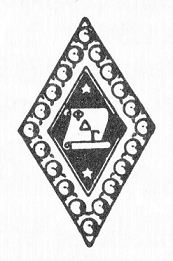Top Qs
Timeline
Chat
Perspective
Phi Delta Gamma (professional)
American forensics fraternity (1924–1935) From Wikipedia, the free encyclopedia
Remove ads
Phi Delta Gamma (ΦΔΓ) was an American professional fraternity in the field of forensics (public speaking).[1][2] It merged into Tau Kappa Alpha in 1935.[3][1]
Remove ads
History
Summarize
Perspective
Phi Delta Gamma was founded on June 7, 1924, at the College of William & Mary, combining local literary society's from the University of Iowa, Georgetown University School of Law, the University of Minnesota, the University of Illinois, Ohio University, George Washington University, and the University of Southern California.[1][4] Its founders were members of a committee that was organized after a 1922 meeting held in Urbana, Illinois.[3]
- William O. Moore, State University of Iowa
- George O. Hurley, State University of Iowa
- Kenneth E. Oberholtzer, University of Illinois
- Dean William A. Hamilton, College of William and Mary
- Russell D. Tubaugh, Ohio University
- Paul A. Lomax, University of Southern California
- William Waldo Girdner, George Washington University
- Carl E. Anderson, University of Minnesota.
The fraternity's purpose was to "maintain and stimulate a greater interest in the work of literary societies, debate clubs, and dramatic organization in colleges and universities and to foster the upbuilding of literary societies."[1]
Phi Delta Gamma was a founding member of the Professional Interfraternity Conference in 1928.[6] Phi Delta Gamma merged into Tau Kappa Alpha in 1935.[3][1]
Remove ads
Symbols
The fraternity's badge was illustrated in Baird's as a diamond shape with an enameled center that featured a scroll with the Greek letters ΦΔΓ on it in the diagonal, from the left corner of the scroll to the bottom right corner. There was a star above and below the scroll.

Membership
Phi Delta Gamma's members included male undergraduates, graduate students, and faculty.[2][7][4] Membership was through a pledging and initiation process, with new members being elected based on debating experience, qualities of scholarship, and interest in literary events.[8][9][10] The fraternity also awarded honorary memberships.[11]
Activities
Phi Delta Gamma pursued intersociety rather than intercollegiate forensics.[1][12] Its activities included debates and forensic contests, awarding silver loving cups to members of the winning team.[1][13] The DC Alpha chapter awarded a silver loving cup annually to winner of a freshman oratory contest, while he CA Alpha chapter awarded a loving cup annually for the best speech in the state.[14][15][16] The VA Alpha chapter purchased three gold medals to be awarded annually for "unusual merit" to a men and women in forensics and either a man or woman for dramatics at the College of William and Mary.[17] The society's members also organized guest speakers and social events such as an annual banquet.[11][18][19]
Remove ads
Governance
Chapters elected the following officers: president, vice president, secretary, and treasurer; some chapters had a sergeant-at-arms and chaplain.[17][20][21]
Chapters
Summarize
Perspective
Following is a list of the chapters of Phi Delta Gamma. [a]
Remove ads
Notable members
- Theodore F, Koop (IA Alpha) – Vice President of CBS. editor for The Associated Press and director of National Geographic's news service[27][28]
- Lee Loevinger (MN Alpha) – jurist, lawyer, and Commissioner of the Federal Communications Commission[29]
- Norman Shumway (MN Alpha) – a pioneer of heart surgery[30]
See also
References
Wikiwand - on
Seamless Wikipedia browsing. On steroids.
Remove ads

